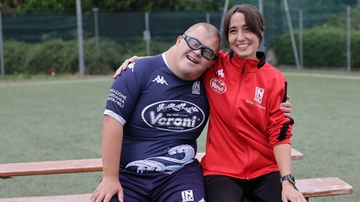Women's football is (finally) growing, even in Italy

The European Women's Football Championship kicked off on July 2nd in Switzerland, and after an encouraging start in the opening match (1-0 against Belgium), the Italian national team was held to a 0-0 draw by Portugal and will play the qualifying match against Spain today, Friday, July 11th. But beyond the news strictly related to the results, there's something else to say about this championship: it seems that women's football is finally growing , both in terms of interest in the sport and financially, although it still remains far behind the numbers of its male counterparts. This success can perhaps be described as unexpected, but is evidenced first and foremost by the number of tickets sold for this European Championship: more than 600,000 before July 2nd, with 22 matches already sold out. During the entire last edition, sales had stalled at 570,000 by the end of the competition. Then there are the figures regarding the television broadcast, sold in 190 countries, with an estimated half a billion viewers. And then there's the growth in total prize money, from €16 million in 2022 to €41 million this year, with a maximum of €5 million—more than double the amount awarded three years ago, as highlighted by the specialist publication L'ultimo uomo—for the winning national team.
Women's football in ItalyThese data are part of a general positive trend , which also affects Italy: 40% of the Italian population is interested in this sport, television audiences have grown considerably, and sponsors' interest has also increased. This generally favorable context is captured in the Deloitte report (on data for 2023-24) and published last April. As mentioned, the popularity of women's football is growing. Currently, 40% of the Italian population declares an interest in women's football, and 7 million Italians declare themselves fans: a figure that has soared compared to the one million of the 2019-20 season. This interest is reflected in stadium attendances —where spectators have doubled compared to the 2021-22 season—and in television audiences , which have grown considerably thanks in part to free-to-air broadcasts on generalist channels, reaching 320,000 viewers. And the growing numbers are attracting more and more sponsors, who represent the main source of direct revenue for the Women's Serie A clubs, contributing approximately 65% of the total.
The growth is also reflected in the financial situation, with average club revenues rising from €0.7 million in the 2021-2022 season to €1.1 million in the 2023-2024 season, a 48% increase, and commercial revenues growing by 36%. However, there was also an increase in costs , mainly due to the FIGC's transition to professionalism in Serie A, which only took place in the 2022-23 season. The growth was mainly generated by the increase in personnel costs (i.e. the salaries of the players), which grew from €1.6 million in the 2021-2022 season to €2.6 million in the 2022-2023 season.
The transition to professionalismItalian women's football recently took a historic step toward professionalism : on July 1, 2022, the Serie A women's league officially became a "professional league." This transition (finally) marked the end of amateurism for top-level female players, who now enjoy contracts, protections, and salaries regulated on par with their male counterparts. This long-awaited milestone was the result of the mobilization of athletes, associations, and institutions, who pushed for full recognition of players' sporting and employment rights. Today, female Serie A players enjoy social security and healthcare protections, with finally adequate contractual frameworks.
The lag behind other European countries—such as Germany, France, and England—is due to a combination of cultural, economic, and regulatory factors . For decades, women's soccer was relegated to the margins of the Italian sports system, considered a minor sport with no real commercial potential. Low media visibility, a lack of investment, and the lack of adequate facilities have slowed the movement's development. Furthermore, until 2020, Italian law formally prevented women from playing professionally : all athletes were legally classified as "amateurs." Only with legislative intervention and the push of the FIGC was it possible to bridge this gap. Professionalism is therefore the starting point for a broader cultural shift, which now requires continuity, investment, and genuine attention to gender equality in sport, but which currently appears to be starting to yield initial results.
Luce







